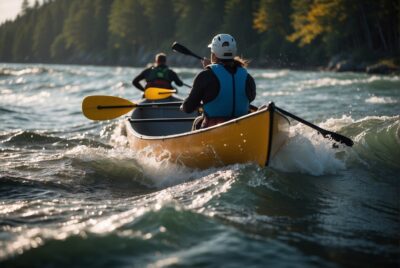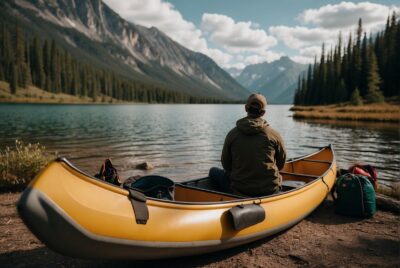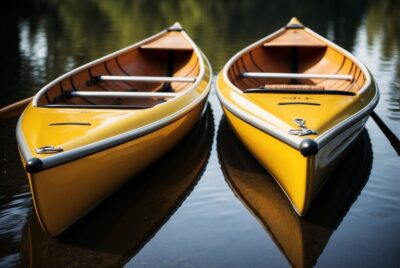Parts of a Canoe: Understanding the Essentials for Paddlers
*We may earn a commission for purchases made using our links. Please see our disclosure to learn more.
Parts of a Canoe: Understanding the Essentials for Paddlers
As an avid paddler, I have a wealth of experience with the various parts of a canoe. These components are essential to the vessel’s performance on the water, and each plays a specific role. Understanding these elements is crucial, whether you’re a beginner just getting your feet wet or an experienced canoeist refining your knowledge.
The hull is the core of the canoe, the shell that gives the boat its shape and buoyancy. It is designed to navigate through the water efficiently, with its shape affecting speed and stability. The bow and stern are the front and back ends of the canoe, respectively, often distinguished by design, with the bow typically cutting through the water and the stern trailing behind. Inside the canoe, thwarts provide structural support by connecting the sides of the boat, while the yoke is critical for portaging, allowing the canoe to be carried over land.
The deck is the part of the canoe above the hull at the bow and stern, protecting the canoe from water and providing additional structural integrity. Gunwales run along the top edges of the canoe, adding to the overall strength and providing a point of attachment for seats and thwarts. The seats are where paddlers sit or kneel, crucial for comfort and proper paddling technique. Knowledge of these terms and components enhances one’s ability to select, maintain, and maneuver a canoe, making it an indispensable part of the canoeing experience.
Design and Structure

As someone well-versed in canoe design, I recognize its profound impact on performance. The design and structure of a canoe are crucial for stability, speed, maneuverability, and ultimately the paddler’s safety. Let’s explore the specifics.
Hull Types
Rounded Hull: Provides less initial stability but better secondary stability, ideal for swift waters.
V-Shaped Hull: Cuts through water, enhancing speed and straight tracking, but may feel tippy.
Flat Bottom: Offers great initial stability on calm waters, commonly found in recreational canoes.
Shallow Arch Hull: A compromise offering moderate initial stability with improved efficiency over flat bottoms.
Multi-Chine Hull: Delivers a balance of stability and efficiency, with multiple points of contact in the water.
Materials and Build
Wood: Traditional, aesthetic, and may be covered in canvas for protection; requires regular maintenance.
Aluminum: Durable, low-maintenance, and lighter than wood, but can be noisy and conduct heat and cold.
Vinyl: Often coats durable materials like royalex or polyethylene for a sturdy build.
Shape and Stability
| Feature | Impact on Stability | Impact on Performance |
| Beam | Wider beam increases initial stability | May reduce speed due to drag. |
| Sides | Flared sides can deflect water and increase freeboard. | Can influence maneuverability. |
| Roker | More rocker enhances maneuverability. | Less rocker improves tracking. |
| Profile | Lower profiles reduce wind resistance. | May affect the canoe’s buoyancy. |
My canoe design accommodates carefully positioned flotation devices to enhance buoyancy without compromising storage space. The stern and bow are designed to afford ample water displacement for a smooth ride, while stems, or the ends of the hull, ensure streamlined movement through water.
Parts of a Canoe: Seating and Comfort

When it comes the design, seating and the elements related to it are crucial for ensuring comfort during paddling. A well-thought-out seating arrangement contributes to better control and stability, and can also aid in reducing fatigue during long outings.
Thwarts and Yokes
Thwarts are the horizontal crosspieces that stretch from one side of the canoe to the other. They serve multiple purposes:
- Provide structural support to the canoe
- Offer paddlers something to brace against when facing rough waters
- Assist in carrying the canoe when out of the water, especially if the canoe is equipped with a yoke—a thwart designed for comfortably resting the canoe on the shoulders.
When seated, I find that the placement of thwarts can also impact my comfort on the water since they can interfere with a relaxed paddling stroke if positioned improperly.
Seat Types and Positions
The seat types and their positions in a canoe can vary greatly, but all aim to balance comfort and paddling efficiency. Here is a quick overview of common seating options:
- Webbing seats consist of a wood frame with nylon webbing, offering a blend of support and give.
- Cane seats also use a wood frame but have a traditional cane surface, which is both lightweight and breathable.
- Molded plastic seats may include features such as backrests for added support, particularly beneficial during extended trips.
For seating positions, I have two primary options: sitting and kneeling.
- Sitting on a seat is the standard position. The height and angle of the seat affect my center of gravity and thus the stability and control. Opting for a kneeling position close to the thwart, with knees bent and resting against the sides of the canoe, can lower my center of gravity even more, which greatly increases stability.
In either case, the design of both the seat and thwart positions determines how effectively I can shift my weight and maintain comfort throughout my journey.
Parts of a Canoe and Functionality

Decks and Gunnels
The deck is situated at the bow and stern of the canoe, providing critical structural support to the vessel. Decks help shield the canoe from water splash and add rigidity to the build. Meanwhile, the gunwales run along the top edge of the canoe’s sides. These elements serve multiple roles: they offer a strong frame to which the thwarts and seats attach, contribute to the shape of the canoe, and they’re also the part I grasp when I need to carry the canoe (a process known as portage).
Keels and Handles
A keel runs along the bottom center of the canoe’s hull and can be instrumental in aiding straight-line tracking in the water. Not all canoes have a keel; it’s a matter of personal preference and intended use. Handles, or tumblehomes, are the curved sections where the sides of the canoe sweep inward as they rise from the keel to the gunwales, which affect secondary stability by allowing easier reach over the side and into the water.
Flotation and Steering
Proper flotation is key to a canoe’s safety; it ensures the canoe remains buoyant in case of capsizing. This is often achieved through the use of buoyancy tanks or foam blocks. Steering is predominantly managed by the paddler’s skills, but the design plays a vital role too. The chine, where the bottom of the canoe meets the sides, often shapes how the canoe moves through the water. A hard chine, for instance, cuts into water for better tracking, while a soft chine allows for easier turns and maneuverability. The shape and design of the stern will also influence the steering capabilities; a sharper stern allows for improved tracking, whereas a more rounded stern allows for better maneuverability.
Frequently Asked Questions

1. What is the stern of a canoe, and how can it be identified?
The stern of a canoe is the rear or back part. It can be identified as the end opposite the bow, which is typically where the stern seat is situated, closer to the end of the canoe with less space between the seat and the stern.
2. What purpose does the yoke serve in a canoe’s design?
A yoke in a canoe’s design is a crossbeam situated near the center of the canoe, often contoured to fit over the shoulders for portaging. It provides balance and makes it easier for me to carry the canoe over land.
3. How are the ribs of a canoe constructed, and what functionality do they provide?
The ribs are constructed typically from strips of wood or composite materials shaped and bent to form the frame. They provide structural support, shape, and rigidity to the canoe’s hull, enhancing durability and performance.
4. What is the bow of a canoe, and what are its characteristics?
The bow is the front end, recognizable by its pointed shape that cuts through the water. The bow seat usually has more space between it and the end of the canoe, and the bow is designed to optimize the canoe’s forward movement.
5. Can you name the various parts that constitute a traditional Hawaiian canoe?
A traditional Hawaiian canoe, or wa’a, includes the hull (kino), outrigger float (ama), connecting spars (iako), deck (papa he’e nalu), and sometimes a sail. The elements are designed for stability and navigation in the ocean currents and waves.




